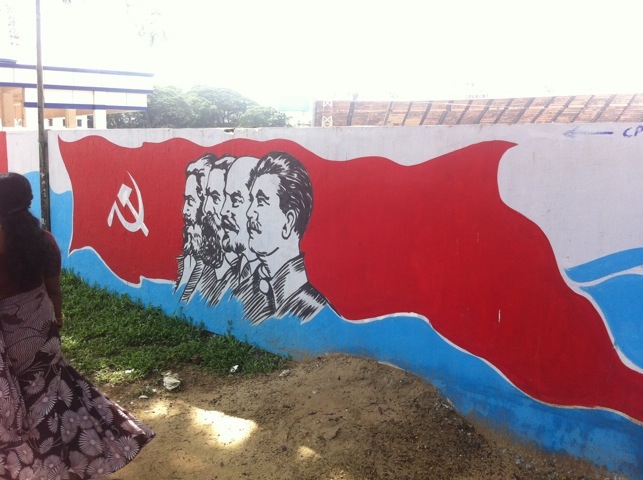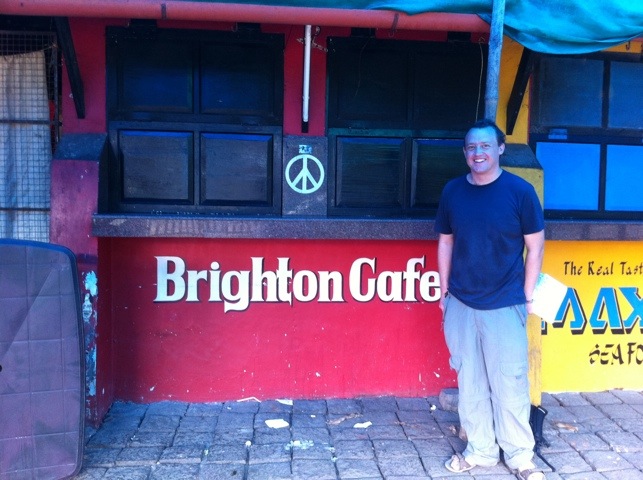Kerala feels very different to the rest of India we’ve seen. I’ve mentioned before the lush greenery that envelops the space between the brickwork, but it became clear to us that there was something more than just this. Firstly, Kerala’s very obviously communist, with red flags and slogans painted everywhere. The government has had a good success rate with tackling poverty, which was clearly evident by the lack of street kids which have followed us around elsewhere. Secondly, Kerala’s the first place in India that we’ve seen Churches – and although only 20% define as Christian (compared to 50% Hindu), it’s certainly the most visible religion, with churches, chapels and crucifixes everywhere. Combined with the colonial buildings leftover from Portuguese and British periods of influence, this gives it a distinctly European feel. We especially appreciated it on a walking tour of Fort Cochin, between the Santa Cruz Basillica and the St Francis Church, built in 1503 and the oldest European church in the country, on the way passing the former parade ground and that classic English institution, the Members Club.

Kochi is a city spread across a clutter of both natural and manmade islands on the coast, with the tranquil Fort Cochin where we stayed a stark contrast to the container ship docks and naval air base across the water. The city is most famous for its iconic Chinese fishing nets (pictured below), which require at least four people operating them to haul in their catch. Sadly we didn’t see them in operation, but did see a lot of fishermen with poles fighting a losing battle with the floating water hyacinth that clogs up the waterways all around here.

We were staying in a huge bargain room above Oy’s Restaurant, home to some of the tastiest fish curries we’ve ever eaten – a great base for our final stop in India. From here, we made what seemed like a marathon trek down to Mattancherry, home to the quarter somewhat crudely known as ‘Jew Town’, where there’s a synagogue and a suite of antique furniture shops, which were started by entrepreneurs who bought up the possessions from Jews migrating to Israel en mass in the fifties. We also found (after nearly giving up in the heat) the Dutch Palace, now a museum on the area. Kerala’s present day radical politics may have found some inspiration in the customs of the past – we learnt about the commanding role women used to play in the family, with inheritance following the female heir in stark contrast to the west. The exhibition also told us this is not the case anymore – although women still have an elevated status compared to elsewhere – with the elimination of this system a result of the ‘modernising reforms’ brought in by the British. That’s progress for you!
Our final night in India saw Laura don her Sari one final time, and us go to a night at the (tourist) theatre, to witness a bit of traditional Kathakali ‘story-play’ – something mentioned in ‘The God of Small Things’, if you’ve ever read it. Before the show, we got to see the make-up going on, and then an intro to how the art form works, with nine facial expressions used to express emotions – from obvious ‘love’ to the more confusing ‘pathos’ – combined with a sign language, movement on stage, and live music. Most impressive was the combination of costume and make-up on the two male performers, who were utterly transformed – and we were transfixed, even if the somewhat misogynistic story of the evil female seductress didn’t appeal to our tastes. As we left the performance for a meal to celebrate our time in India, the heavens opened, and we finished a memorable five weeks dining on tuna and prawn curries while watching the thunderstorm around us – an electric experience in more than one way, and one we’ll certainly be back to repeat in the future.

Simon
PS. One quick reminder of home!



